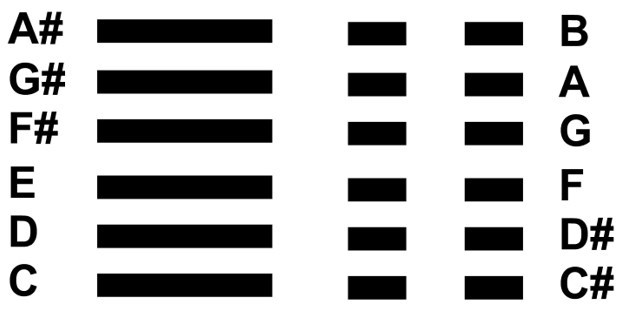Scales 1 Intro: Musical Scales for the I Ching Hexagrams
The Hexagrams to Musical Scales
64 Scales To An Octave
In the development of tuning systems for the Celestial Harp, an instrument invented to play the I Ching and Astrology, a lot of thought was put into the I Ching and music. The original system was invented by Brian Roche who developed and refined it. Brian has recordings of his own playing I Ching hexagrams on various instruments. We worked on various systems with various instruments and computers. It sounded great and felt good but had the idiosyncrasy of being a descending scale instead of an ascending one and this scale left a gap between the two trigrams.
Years later while working with the scale, another version became apparent to me. It is this version that is presented in this appendix. As with many I Ching revelations, they come after you give up trying to figure them out! This was indeed the case.
In a chromatic scale there are twelve notes. Brian and I had been trying to work with the seven note scales. How could the six lines fit in? So when the ideas transposed over to the chromatic scale of twelve even intervals, the correspondence became apparent.
The first note in the scale will be a yang or solid line in the first place (C).
The next whole note in the scale will be a yang or solid line in the second place (D).
The next whole note in the scale will be a yang or solid line in the third place (E).
The next whole note in the scale will be a yang or solid line in the fourth place (F#).
The next whole note in the scale will be a yang or solid line in the fifth place (G#).
The next whole note in the scale will be a yang or solid line in the sixth place (A#).
The yin or broken lines are a semi-tone away from the yang or solid lines.
A broken line in the first place will be (C#).
A broken line in the second place will be (D#).
A broken line in the third place will be (F).
A broken line in the fourth place will be (G).
A broken line in the fifth place will be (A).
A broken line in the sixth place will be (B).
This can be seen in the accompanying diagram showing the six solid lines and notes on the left hand side and the six broken lines and notes on the right hand side.

In the rest of this appendix the scales for the upper and lower trigrams are listed as are the scales for each of the 64 I Ching hexagrams.
Appendix 11 will be about the Celestial Harp. Recordings from this can be found at https://www.thecelestialharp.com/
After years of working with the rhythms of change, the melodies of change became apparent. As with other areas of correspondence the I Ching adds new dimensions of perception and insight into music.
The test of course is in the playing or applying these changes to music. A new level of sensitivity and impressionability opens up through which one may evaluate the hexagrams.
Because of the words to the changes, a new literacy also becomes applicable.
This has been a delightful application of the I Ching for me. Hopefully it will also be delightful for you.
“Spirit is bound to no one place, nor the book of changes to any one form!”
